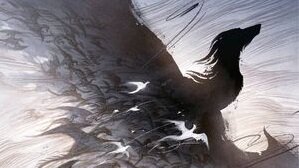Each year (well, kind of) we take a look at the Nebula-nominated works in the short story, novelette, and novella categories. We’re buying lotto tickets this year, because it turns out we read and even reviewed most of them long before they were award nominees. Check out our full reviews linked below, and some new favorites of ours!
Sean Cassity, on P. Djèli Clark’s The Black God’s Drums
“P. Djèlí Clark beats a hammer of imagination against the anvil of history and forges a dense alternate history,” I wrote in my review last August. “The pages hum with city activity. Wheels and six-legged contraptions bounce off the cobble stones as Clockwork Orange-inspired gangs roam looking for a fight. It’s a world which could support many more exploits than the novella form allows. When a novella is this good, my only issue is wanting more. More complications, more exploration of the villains, more of a second act. Where it does go deep is just so damn satisfying.” Read the full review of The Black God’s Drums here.
C.H. Lips, on Kate Heartfield’s Alice Payne Arrives
Time travel stories present a tricky challenge to writers—which to do: take a hands-off approach to the complicated mechanics and paradoxes, or accept the challenge and explore those aspects in a readable, not overly science-y way. In her Nebula nominated novella, Alice Payne Arrives, Kate Heartfield embraces the challenge with a story that is both entertaining and brain-friendly.
For ten years, Major Prudence Zuniga has been traveling back in time from 2045 to 1889 attempting to prevent WWI. She’s an operative for the military group “The Farmers,” who are battling “The Misguideds,” each with their own idea of how to change history to create a better world. After her seventy-first failure to foil the suicide of Austria’s crown prince, Rudolf, Prudence realizes the futility of the History War and decides to end humanity’s ability to change the past. To accomplish this, she must go to the past and install a device that will scramble the space-time map time travelers use to arrive at an exact point and time in history. She chooses 1788 England, Fleance Hall, as the time and place to plant her device—the time and place in which the charismatic titular character, Alice Payne, lives.
Alice is the daughter of an English nobleman, who is a PTSD-suffering veteran of the Revolutionary War. The story opens with Alice dressed as a masked highwayman known as the Holy Ghost, whose antics along the wooded tract near Fleance Hall have become legend. Alice’s thievery has two goals—to raise money to maintain her home and support herself and her father, and to lighten the purses of certain nobles who have a habit of mistreating women. Her thefts are aided by an automaton designed and built by her companion and secret lover, Jane Hodgson, whose scientific talents combined with her lowly social status make her the perfect person to set off Major Zuniga’s device.
But when Alice discovers a time traveling instrument Prudence left behind in 1788 and arrives in full Holy Ghost attire in 2070, it is Alice, not Jane, who becomes Major Zuniga’s trigger puller. Prudence’s careful plan comes to depend on impetuous Alice, whose local constable has been sniffing around Fleance Hall asking too many questions about the Holy Ghost.
Heartfield’s story takes on other complex topics besides time travel. Not only does Alice’s sexual orientation defy 1788 norms; so does her ethnicity. Her father is a white English estate owner, and her mother (absent from Alice’s life) is from the Caribbean. Alice maintains the social status of her white counterparts but her skin and hair are like her mother’s, and the locals never fail to note the difference. Prudence, born of Belizean parents, has to deal with the limitations imposed upon women of color as she tries to change the outcome of WWI. I applaud Heartfield for her complicated character choices, though I found myself wishing that she’d had the room of a novel to further explore these strong women characters and the varied possibilities of this time traveling world. The good news is there is a sequel, Alice Payne Rides, released by Tor in March 2019.
A tip of the hat to Heartfield for collecting two 2019 Nebula nominations, the second earned in the game category for The Road to Canterbury.
Lisa Mahoney, on Aliette de Bodard’s The Tea Master and the Detective
On her website, de Bodard describes the The Tea Master and the Detective as “my gender-swapped retelling of Sherlock Holmes in space, with Watson as a traumatized transport warship and Holmes as an eccentric scholar looking for a corpse to study.” But de Bodard’s tale is not more Englishmen (or Englishwomen) in a Euro-centric outer space. Rather, hers is an intricately-carved, alternative-history universe in which Vietnamese and Chinese cultural influences dominate, from a Confucian-influenced governmental meritocracy, to Buddhist nuns, to an Empress and influential great houses. Here, Mindships with human-birthed cores travel the soul-searing deep spaces between the stars protecting their human passengers. The shipminds function as A.I.s for their physical vessels, and as avatars projected into the human world, which can enjoy memories and sensations evoked by being served a computer version of tea with friends.
The Shadow’s Child Mindship is deeply traumatized by a wartime catastrophe, like Watson, which took the lives of her crew in deep space while she was unable to respond. Long Chau is the seemingly emotionally-insensitive, Holmes-like, drug-using yet brilliant detective who first hires The Shadow’s Child to brew her a chemical concoction to allow her to enter deep spaces without losing control or focus.
De Bodard is Vietnamese and French, born in the USA and raised in Paris, and she shows a clear understanding of outsiders. She trained as a computer programmer focusing on imaging technology, and visual imagery and projection is an important element in Tea Master. In this universe, shipminds project themselves in different, even rotating, forms into human realms, and clues to the murder mystery include analyzing the victim’s choices of what she projected upon her living spaces for herself, friends, and strangers.
The Tea Master and the Detective is nominated for the Hugo and Nebula novella awards. De Bodard’s series of loosely related short stories and novellas set in this Xuya universe is a 2019 finalist for the relatively new Best Series Hugo award. Winning would see her join Lois McMaster Bujold, the only other winner (so far, and twice) of this category.
Theodore McCombs, on Kelly Robson’s Gods, Monsters, and the Lucky Peach
“Time is the new river, and alternate timelines are the waste TERN dumps in it,” I wrote back in March, when I reviewed “Lucky Peach for Fiction Unbound. “We all know the story of how waste dumping, disposable commodities, and ‘externalities’ lead to environmental destruction. ... Robson’s insight is to connect those attitudes to time travel adventures themselves, as a unified fantasy of escaping consequences.” (Ahem, ahem, Avengers: Endgame.) Read the full review of Robson’s Nebula-nominated Gods, Monsters, and the Lucky Peach here.
C.S. Peterson, on Jonathan Brazee’s Fire Ant
Author Jonathan Brazee is a retired marine colonel and combat vet who writes military science fiction. His self-published works are full of the tropes and expectations that fans of this sub-genre of the speculative universe know and love. Fire Ant is no exception. Beth, a small but feisty Filipina heroine, ends up working for a nasty corporation that treats its employees like property. But, out on her own, in her tiny, spartan ship, with her A.I., she travels fast. In this universe so far humans have found themselves curiously alone. No aliens anywhere. But our pilot Beth gets attacked, by something... and it isn’t human. Problem is, no one will believe her.
Fire Ant is fast paced, and a quick, fun read. Military space opera comfort food, when you need a little something to pick you up on lazy summer afternoon, or a quick fix on your Kindle to while away a flight. It looks like this will be one of a series the author plans to write in this universe.
Mark Springer, on Martha Wells’s Artificial Condition: The Murderbot Diaries
A year ago, Martha Wells took home the Nebula Award for Best Novella for All Systems Red, which introduced readers to Murderbot, a rogue security android (“SecUnit”) suffering from social anxiety and depression. It’s a clever and satisfying subversion of the Rogue AI trope: far from being a “heartless killing machine,” Murderbot just wants to be left alone to binge-watch space exploration-themed soap operas. This necessitates the rogue SecUnit hiding in plain sight by pretending not to be rogue. The deception works until Murderbot breaks cover to save a team of human researchers from being murdered by the GrayCris corporation. Complications ensue, and Murderbot is set on a journey of self-discovery that continues into a second volume, and beyond.
Fast forward to today, and the second Murderbot volume, Artificial Condition, is also in the running for Best Novella. This time around, Murderbot is determined to get to the bottom of a formative event in its past—the time when it was a heartless killing machine. The SecUnit knows it went rogue once before, years ago, but it has no actual memories of what happened. Did it kill a bunch of humans, then hack its governor module? Or did it hack its governor module in order to kill a bunch of humans? The distinction is important, obviously. It speaks to deeper questions about Murderbot’s nature, its identity, and whether its self-control is an illusion. Questions that make this origin story satisfying in its own right, and a perfect setup for the excellent third and fourth volumes in The Murderbot Diaries.















Cadwell Turnbull's new novel — the first in a trilogy — imagines the hard, uncertain work of a fantastical justice.